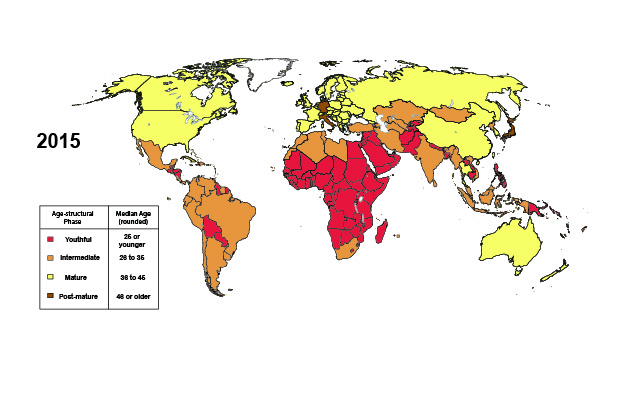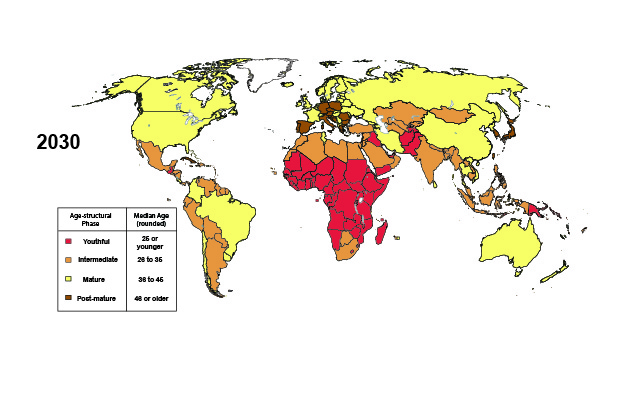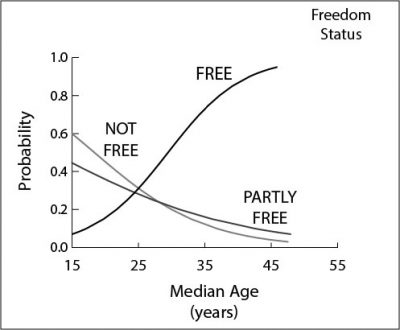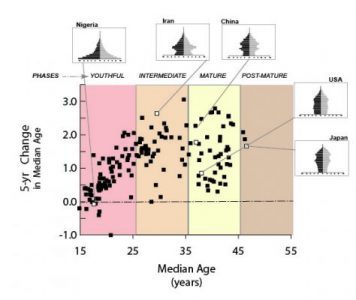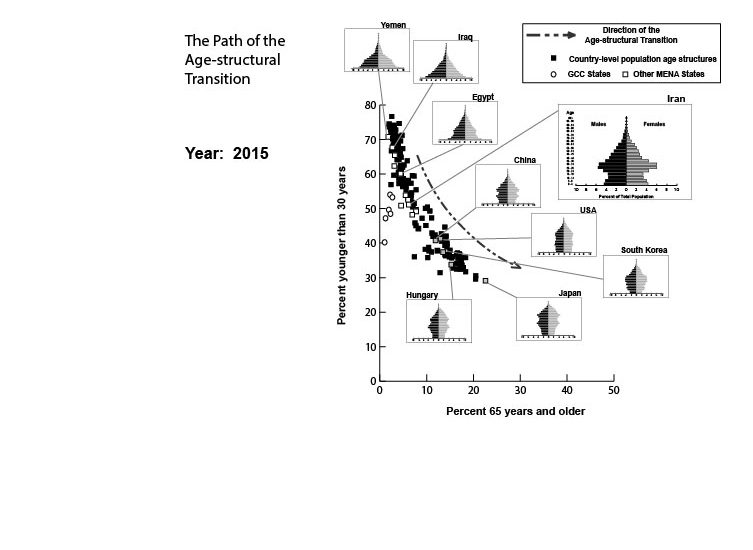
Welcome to politicaldemography.org
Age Structure: The Root of Sub-Saharan Africa’s Governance Problems?
December 11, 2023 By Richard Cincotta

Sub-Saharan Africa’s sluggish economic growth and brittle political structures are clear challenges for the region. And two major development theories—one strictly political, the other demographic—seem to steer parallel courses in explaining them.
On one hand, a growing number of Africa’s political analysts and academics are drawn to the conclusion that weak governance lies at the root of the slow economic progress and acute political fragility that stifle development in most of sub-Saharan Africa’s nearly four dozen states. Yet political demographers have argued that the persistently youthful population age structures (Fig. 1) that are a characteristic of nearly all of this region’s countries have constrained their socioeconomic development and sustain their vulnerability to coups d’état and civil conflicts.

Figure 1. Phases of the Age-structural Transition
This disciplinary standoff took an odd twist when I began examining the six categories of data bundled into the World Bank’s Worldwide Governance Indicators database. These measures indicate that countries with youthful populations are generally assessed to have weak governance—a generalization that spans all six of the WGI categories and affects virtually every country within the tropical midriff of Africa (from Senegal to Somalia, then southward to Angola and Mozambique).
This finding suggests something startling: these two seemingly irreconcilable theories may simply be one in the same—or, at least, they conspicuously overlap.
Measuring Governance
The rising tide of criticism of governance in sub-Saharan Africa has met with little resistance—or even evaluation. So access to the World Bank’s Worldwide Governance Indicators (WGI) Dataset provides my new research with a means to objectively compare the relative strength of governance in and among sub-Saharan African states, and then evaluate the merit of this increasingly vocal critique.
The Worldwide Governance Indicators summarize multiple types of surveys that assess how strongly (or weakly) governments have responded to each of six scored categories: (a) government effectiveness; (b) control of corruption; (c) rule of law; (d) political stability and absence of violence/terrorism; (e) voice and accountability; and (f) regulatory quality.
From 1996 to the present (with omissions), Worldwide Governance Indicators governance scores have been generated from responses obtained in surveys of enterprises, citizens, and experts collected by survey institutes, think tanks, non-governmental organizations, international organizations, and private sector firms. Nearly all governance scores range between -2.5, which indicates a near-consensus of weak governance, and +2.5, indicating a near-consensus of strong governance.
Research Questions
My examination of this question begins by attempting to validate (or refute) the criticisms of sub-Saharan Africa’s governance using the six Worldwide Governance Indicators. Are claims of widespread weak governance in sub-Saharan Africa supported by governance data? If so, how well, on average, do these assessments of the region compare with other places?
Next, my work assumes a demographic perspective. It turns to age-structural modeling (a statistical tool originally designed by and for strategic intelligence analysts) in order to uncover trends in governance scores that could be associated with a population’s advancement through the age-structural transition. This particular demographic process is driven largely by fertility decline, and it transforms populations that are numerically dominated by children and young adults into distributions in which the majority of residents are middle-aged and elderly.
After positioning all governance data along the age-structural transition, we can proceed to ask a pair of related questions: Is there a global statistical relationship between governance and population age structure (measured by median age)? And, if so, how well—or how poorly—does age structure explain weak governance in sub-Saharan Africa?
Are the Criticisms of Sub-Saharan Africa Legitimate?
If we accept the Worldwide Governance Indicators as unbiased measures of the quality of governance, then sub-Saharan Africa’s critics have a valid point. The vast majority of countries within the two sub-Saharan regions in this study possess weak governance assessments (negative scores), in each of the six governance categories (Fig. 2). Notably, there are only two small sets that constitute exceptions: one set located in Africa’s southern cone (Botswana, Namibia, and South Africa), and a second set among the small island states that ring the continent’s eastern and western coasts.

Figure 2. Average Governance by Region, 2020.
Only one other region rivals the two sub-Saharan regions in assessments of weak governance. This region encompasses the countries of the Middle East, North Africa, and Central Asia, and it features very low average negative governance scores in two Worldwide Governance Indicator categories: political stability and absence of violence/terrorism, as well as voice and accountability.
Links Between Governance and Age Structure
One surprise in examining the question is that governance is statistically—and quite consistently—related to population age structure. Regardless of the governance category, the age-structural patterns described by weak governance (negative scores) are virtually identical (Fig. 3).

Figure 3. The Probability of Weak Governance Across the Age-structural Transition
For nations in the earliest portion of the youthful phase (low median ages), the chances of being assessed with weak governance (a negative governance score) are extremely high—consistently greater than 0.90 in all governance categories. As age structures mature, the propensity to govern weakly tends to decline steeply, ultimately dropping below a probability of 0.50 toward the middle of the demographic window—a development-favorable segment of the age-structural transition beginning near a median age of 26 years and ending around 40 years.
So far, statistical modeling has identified two exceptional groups of countries. The so-called least-populated states (countries with less than five million residents, such as Botswana, Namibia, and most small island states, including Cabo Verde, São Tomé, and Mauritius) tend to govern more strongly than expected for their median age in all governance categories. By contrast, resource-reliant states (countries in which oil and mineral rents comprise more than 20.0 percent of GDP) tend to govern more weakly than expected—but only in half of the Worldwide Governance Indicators’ six categories: government effectiveness, voice and accountability, and regulatory quality.
How Weakly Do Youthful Countries Govern?
Among the most youthful countries, positive (strong) governance scores are relatively rare. Negative (weak) governance scores vary. The study concludes that age structure accounts for about 50 percent of the statistical variation in governance scores on average. What accounts for the remaining variation has been difficult to determine thus far. Ultimately, it may be near-impossible to test.
To illustrate both trend and variation, the study generates six scatter-graphs—one for each Worldwide Governance Indicator category for the year 2020 (Fig. 4). Despite considerable individual-country variation around the statistical trendline (red dotted line), the graphs show strong commonalities: (a) similar scatter patterns; (b) linear trendlines with nearly identical slopes; (c) similarly timed shifts from negative to positive governance scores during the demographic window (shaded in blue); and (d) few weak governance scores over the median age of 35 years.

Figure 4. Governance Scores Across the Age-structural Transition, 2020.
Notably, this relationship between age structure and governance is global in scope. Weak governance is not unique to sub-Saharan Africa. Wherever countries remain in the youthful phase of this transition—whether positioned along the tropical midriff of Africa, in the core of the Middle East, in the Americas, or elsewhere—their governments are likely to be assessed with negative scores in all governance categories.
Age Structure and the Supply Side of Governance
Looking anew at the question of governance offers us some relevant new perspectives on the questions that opened this essay. Political demographers have focused primarily on the demand-side challenges of population age structure—stresses (and bonuses) associated with the movement of bulges through the age profile (see Fig. 1). In the youthful phase of the age-structural transition, their research has dwelt on the unmet needs for education, healthcare, and jobs among the large and growing proportions of children and young adults (the youthful bulge). In the post-mature phase, their attention has been fixed on the future needs of a growing proportion of retirees (the senior bulge).
Economic demographers take a different approach, studying some of age structure’s influence on the supply of governance. Drawing on data from the National Transfer Accounts Project, they document levels of lifecycle consumption, income, and public and private transfers. These studies suggest that in the absence of substantial resource rents and external sources of income (such as remittances, foreign loans and grants), states with high-fertility youthful populations are limited in their ability to tax and therefore constrained in their capacity to build and maintain key institutions. Thus, while experiencing a surge in children and young adults, youthful countries typically have limited fiscal resources with which to subsidize basic education and specialized training, to fund and improve services, to exercise quality control, or extend a social safety net widely across their population.
Realistic Expectations
What comes from reexamining these two competing development theories? One is a purely political theory which asserts that the widespread fragility and lagging development of most sub-Saharan African states are products of their weak governance. A demographic perspective drives the other theory, which argues that a youthful population age structure constrains the socioeconomic and political progress of its states.
When compared using the World Bank’s six Worldwide Governance Indicators, however, we find little difference between these two perspectives. Demographically, Africa’s weakest states are its youthful countries. And, statistically, youthful countries tend to govern weakly.
My findings will likely prove disturbing to Africa’s political analysts, academics, opposition leaders, and regional organizations. Virtually all of the governments of weakly governing sub-Saharan states have youthful populations. Understandably, these experts and groups will no doubt continue to press them to launch initiatives to govern more effectively, to regulate more competently, to better deter corruption, and to work toward more open, accountable, and violence-free elections.
Some of these weak states may marginally improve. Yet the findings of my fresh look suggest that as long as countries retain their high-fertility, youthful demographic profiles, there are real limitations to what citizens can expect from the performance of their country’s government. Without substantial demographic change among countries within the tropical midriff of Africa, the problems of weak governance, slow-paced development, and persistent instability will likely continue as the rule, rather than the exception.
Richard Cincotta is a Global Fellow with the Wilson Center’s Environmental Change and Security Program.
Sources: Institute for Security Studies, NSB, World Bank Policy Research Paper, National Accounts Transfer Project
Citation: Cincotta, Richard. 2023 (Dec. 11). Age Structure: The Root of Sub-Saharan Africa’s Governance Problems? New Security Beat (Woodrow Wilson Center). https://www.newsecuritybeat.org/2023/12/age-structure-the-root-of-sub-saharan-africas-governance-problems/
Nigeria’s Demographic Moment? Or Just Wishful Thinking?
July 17, 2023 Richard Cincotta

Over the past several months, members of the foreign affairs and development communities have heaped a great deal of attention—and interpretation—on the pace of demographic change in Nigeria.
This groundswell began in March of this year, when an article in the Economist argued that, due to evidence of a dramatic decline in the lifetime rate of childbearing (the total fertility rate, or TFR), Nigeria should be added to sub-Saharan Africa’s list of promising demographic transitions. Then, the author of a June article in Foreign Policy likened Nigeria’s current demographic conditions to the development-favorable age distributions that began to emerge in China’s population during the 1980s, asserting that Nigeria “has been in the throes of one of the most remarkable demographic transitions the world has seen in the last century.”
If this stunning claim is accurate, it’s very good news. With a much-improved age structure due to emerge in the near future, Bola Tinubu, Nigeria’s newly elected president and the former governor of Lagos state, would be stepping into office at an opportune time to attract investors and refashion the country’s oil-dependent economy.
But are these descriptions really accurate? Or are they just wishful thinking? Frankly, at this point, it’s hard to be absolutely certain—and very easy to be skeptical. Perhaps a closer examination of some of the details of the ongoing controversy over Nigeria’s demographic transition will offer clearer answers.
Disparate Surveys
Enthusiasm over Nigeria’s demographic prospects is owed to two recent countrywide surveys. The first is Nigeria’s 2021 Multiple Indicator Cluster Survey (NMICS-2021), a UNICEF survey designed to estimate a wide range of health indicators among women and children. The second is its 2021 Nigeria Malaria Indicator Survey (NMIS-2021), a USAID-sponsored assessment of Nigeria’s progress toward eradicating malaria.
Each of these surveys has its own focus. For the malaria assessment, childbearing is strictly a secondary calculation. For the Multiple Indicator Cluster Surveys (MICS), maternal and child health are most important. The controversy stems from the fact that abrupt changes in fertility detected in NMICS-2021 and NMIS-2021 follow only three years on the heels of Nigeria’s 2018 Demographic and Health Survey (NDHS-2018), a more intensely sampled, broader USAID-designed survey that most demographers see as the standard for estimating fertility and its contributing factors.
Notably, demographers caution against integrating Demographic Health Surveys (DHS) and MICS results, or even using one set of results to validate the other. (Admittedly, this is something I am doing here). In fact, Nigeria’s implementing agencies routinely expect to encounter variation in their published estimates owing to the year of the survey (the DHS and MICS are purposely staggered) and to differences in samples, field methods, statistical techniques, and logistics.

Despite these caveats, most measures related to childbearing that have been estimated by Nigeria’s MICS over the past two decades seem roughly consistent with DHS. Until recently, that is (Fig. 1a & b).
Figure 1: Total fertility rate: Nigeria’s North and South DHS and MICS.
While demographers have grown accustomed to seeing greater changes across Nigeria’s more densely populated coastal south than in the far north, NMICS-2021 reports that total fertility rates have dropped steeply, and nearly uniformly, across all of the country’s six regions. It is a trend that West African demographers have dearly hoped for but now eye a bit suspiciously.
Demographic Skepticism
Demographers can, indeed, be overly skeptical when faced with unexpected evidence of demographic change. For example, UN demographers repeatedly dismissed early surveys showing the first signs of Iran’s record-breaking decline from more than six children per woman in the mid-1980s to around two children per woman by 2000. During the following decade, a few demographers suspected that much of Bangladesh’s reported shift to the two-child level might be due to sampling error. It wasn’t.
Yet, it pays to be cautious. Populous countries containing several proportionally large ethnic populations, each inhabiting a distinct eco-climatic or cultural zone—like Nigeria, Ethiopia, Egypt, or Pakistan—tend to stall outright, or enter their fertility transition piecemeal. In the latter case, fertility typically declines first in the large cities, after which this effect spreads slowly, region by region, as fertility’s contributing factors—including girls’ educational attainment, delayed marriage, child spacing, and knowledge and availability of contraception—make gains locally.
Like China?
Whether Nigeria’s current total fertility rate is nearer to 5.3 (NDHS-2018), 4.6 (NMICS-2021), or somewhere in between (like NMIS-2021’s estimate of 4.8), the future trajectory of the country’s ethnically heterogeneous population is unlikely to parallel China’s or any of the nearby East Asian tigers’ (Japan, South Korea, Taiwan, or Thailand) more homogeneous populations.

As the June Foreign Policy article points out, China was, itself, in the throes of experiencing a set of age distributions forty years ago that advantageously bulged among working-age adults while featuring relatively small proportions of dependent children and retirees (Fig. 2a, which is narrow at both the bottom and top). Even before Beijing officially set in motion its notoriously coercive One-Child Policy in 1980, China had (according to UN estimates) already dropped to about 2.7 children per woman. If the MICS-2021 estimate of 4.6 children per woman is accurate, Nigeria’s total fertility rate would still be nearly two-children per woman higher than China’s countrywide level at that time.
Figure 2: Age Structures for China, 1985 and Nigeria, 2020.

In contrast to China’s population in the 1980s, Nigeria currently retains much of the youthful age structure (Fig. 2b, a broadly pyramidal profile), rapid growth, and chronic stress on its health and educational services that have constrained its development over the past 60 years.
Figure 3: Three Very Different Transitions: 1980, 2000, 2020, for China, Nigeria, and India.
Rather than focus on China’s rapid fertility transition and the restrictive reproductive policies that took that country to very low levels of fertility (well below 1.5 children per woman), the slower, region-by-region transformations of more ethnically and culturally diverse populations—such as India, South Africa, and Indonesia—offer model trajectories that may be more appropriate for Nigeria and its coastal West African neighbors (Fig. 3).
Nigeria’s North-South Divide
Of all the trends reported by NMICS-2021, the sudden drops in fertility in Nigeria’s two most northerly, culturally Sahelian, and predominantly Muslim regions were the least expected. If confirmed by the next DHS (NDHS-2023, which is already in the field), these declines could represent a narrowing of the fertility gap between north and south. It is a gap that Marcin Stonawski of the International Institute of Applied Systems Analysis and his colleagues suggest coincides with the imposition of Sharia law (beginning in 1999) at the state level in 12 of the country’s most northerly states.
Instead, if the two regions were to continue to diverge, Nigeria’s long-term prospects as a politically unified state would likely dim. Should the country’s future demographic dividends (measurable gains in health status, educational attainment, and income) concentrate narrowly among Nigeria’s densely populated southern coastal states, while political power slowly shifts northward as the nation’s Hausa and Kanuri-speaking populations grow, it would not be unreasonable to expect more visible activism among ethno-political movements in the south—particularly Yoruba nationalism in the southwest, and rekindled Igbo separatism in the southeast.
Getting to the Demographic Window
If the multiethnic, multireligious, multitudes of India can make their way through the transition to two- and three-child families and ultimately advance into the demographic window—beginning at a median age of around 26 years and fading near 40 years (Fig. 4)—why not Nigeria? It wasn’t easy for India’s state programs, nor would it be any easier for President Tinubu’s government, particularly in Nigeria’s north, where the state has made only modest progress on keeping girls in school, eliminating underage marriage, and reducing teen childbearing. But it’s possible. And, if NMICS-2021 is reasonably accurate, the process may already be well underway countrywide.

Figure 4: Getting to the Demographic Window in Nigeria, India, China, 1980-2020.
Whatever the case, Nigeria could do better. Using its oil wealth, the country has generated a large cadre of health professionals with the training to expand and increase the effectiveness of their family planning program while avoiding mismanagement and quality issues. Unfortunately, Nigeria has a poor record of health financing in general, and it has yet to adequately fund its family planning and reproductive health efforts.
Statistical skepticism aside, demographers are hopeful that Nigerian survey teams, now preparing to take NDHS-2023 questionnaires to the field, will find Nigeria’s major demographic indicators to be consistent with estimates obtained from NMICS-2021. Declines in fertility of this magnitude and geographic coverage, while steeper than prior surveys, are not only possible, they’re overdue.
Richard Cincotta is a Global Fellow with the Wilson Center’s Environmental Change and Security Project.
Sources: The Economist; Foreign Policy; Journal of Modern African Studies; The Lancet; UNICEF; USAID
Should Demography Weigh in on U.S. Responses to Coups d’État?

February 14, 2023 By Richard Cincotta
When a military-led or military-influenced coup d’état occur in a foreign country, does evidence from demographic research merit consideration in the U.S. foreign policy response? It’s a question that U.S. policymakers should be asking as deteriorating political conditions in West Africa come increasingly into confluence with the limited tools available either to deter or respond to illegal and extra-legal forms of political succession.
A recent series of military-led takeovers in that region has led several authors to criticize the U.S. government’s inconsistent record of response to coups. The focus of these articles has been the State Department’s reluctance to trigger Section 7008 of the Department of State, Foreign Operations, and Related Programs Appropriations Act—a congressionally-mandated policy intended to encourage a swift return to civilian rule, to ultimately open a path to elections, and to discourage other would-be coup plotters. Once a post-coup regime is identified and Section 7008 is procedurally set in motion, the act restricts expenditures by USAID programs in that country. Currently, the only exceptions to 7008’s punitive restrictions apply to democracy assistance and some types of humanitarian aid.
Some critics argue that to avoid triggering Section 7008 is to flout a law that clearly intends to restrict post-coup regimes that have been installed using military power. Others point out that coups create complex international political situations, and argue in favor of the State Department retaining some flexibility.
Political demography offers an alternative criticism—not of the U.S. State Department’s reluctance to trigger Section 7008, but of its broad restrictions. This criticism argues that Section 7008’s restrictions may not always work in the best long-term interests of the citizens of the countries affected, of the region, or of the United States.
Unlike other foreign-policy perspectives, political demography’s recommendations are rooted in published research that uses models, based on 50 years of age-structural data (estimates of the numerical distribution of residents, by age), to predict various forms of political behavior and socioeconomic performance. A growing body of research demonstrates that countries in the youthful phase of the age-structural transition (Fig. 1), as a group, have been the most likely to be engaged in armed civil conflict, to occupy the lowest levels of social and economic development, and to lose liberal democracy. Recent research on successful coups d’état also shows a similar demographic pattern of risk. In each case, the shift from a youthful to an intermediate age-structure—the result of a decline in fertility to below 3 children per woman—is associated with lower probabilities of political instability and higher probabilities of development.

Figure 1: Principal Phases of the Age-structural Transition
The Golden Rule
From this research comes a general recommendation, or what could be called political demography’s golden rule: Avoid policies that keep persistently youthful populations demographically young. Their consequences can come back to bite you.
Rather than promoting long-term political stability, some of 7008’s restrictions run counter to this recommendation by disrupting social programs that have played critical roles in advancing the age-structural transition—specifically, programs that improve access and quality of family planning and other reproductive health services, efforts that augment girls’ educational attainment, and activities that advance women’s autonomy and rights.
A closer look at the relationship between coups d’état and countries in the youthful phase of the age-structural transition suggests that political demography may offer valuable insights that could offer an occasion to rethink Section 7008 and broader U.S. policy.
Mind the Gap
Even during the Cold War, when the risk of a coup d’état was more than three-times as high as today, a wide and persistent disparity (Fig. 2) existed between youthful countries—as a group, the most vulnerable to coups, regardless of their geographical location—and countries in their intermediate and mature phases. Among youthful countries, those with a population in the so-called early segment of this phase (with a median age of 20 years or less) have consistently been the most vulnerable to a successful coup and the most likely sites of back-to-back coups (coups that occur within five years of a prior coup).

Figure 2: Vulnerability to Coups, by Age Structure
Shifts in population age structure, coupled with the close of the Cold War, provide a statistical explanation for most (but not all) of the recent downward trend in coups. Data compiled by the University of Illinois’s Cline Center indicate that this decline has been steep: from 39 coups in 24 countries (each with a population over 500,000 residents) during the 1990 to 1994 period to a post-World-War-II low of just 5 coups in 5 countries from 2015 to 2019.
Despite concerns raised by the recent uptick in coups (8 coups in 6 countries since the beginning of 2020), political demographers are more worried by the slow rate of age-structural change that the UN Population Division projects for the Greater Sahel (from Senegal and Mauritania, east to Somalia) and tropical Africa (south of the Sahel to Angola and Mozambique). If the predictions of age-structural models prove reasonably accurate, analysts should expect successful coups to occur in 4 to 9 countries every five years, from now to 2040. At least two-thirds are likely to occur in countries in the transition’s youthful phase. Because countries in the early segment of the youthful phase are typically most vulnerable, the Greater Sahel and tropical Africa are likely to remain hotspots for coups d’état (see Map, Fig. 3).

Figure 3: Population Age Structures, 2020 (estimates) and 2040 (projections)
Among countries in either the intermediate or mature phases, not only are coups substantially less frequent, they are also often qualitatively quite different. For example, coups in the intermediate and mature phases are nearly twice as likely as those in the youthful phase to be instigated by a large-scale popular uprising—a so-called color revolution, such as Georgia’s Rose Revolution in 2003, Tunisia’s Jasmine Revolution in 2011, or Algeria’s Revolution of Smiles in 2019. Similarly, later-phase coups have been twice as likely as those in youthful countries to be carried out by a faction within the ruling government (known as a palace coup).
The Constraints of a Youthful Age Structure
One explanation for a state’s vulnerability to a coup lies in the political regime’s inability to meet the demands of governance. Analyses of data from the World Bank’s World Governance Indicators database suggest that, as a group, countries with youthful populations have been scored as the least effectively governed, the least able to control corruption, the least likely to apply the rule of law, and the least politically stable (Fig. 4).

Figure 4: Youthfulness and Governance, 2018
Notably, each of these trends reaches its upper-middle scores (above zero), near the middle of the demographic window—a series of development-favorable age structures encountered midway through the age-structural transition (beginning at a median age of 26 years and ending at about 40 years).
With the exception of some oil and mineral-rich states and a few of the least populous states (less than 5 million residents), youthful countries rarely attain the World Bank’s upper-middle income category or achieve similarly high levels of child survival and educational attainment until they attain the demographic window. Moreover, youthful countries have been the least likely to end persistent and intermittent armed civil conflict—a factor that figures in coups led by junior military officers (for example, the recent back-to-back coups in Mali and Burkina Faso), who typically justify their actions with claims that political leaders and senior military officers were too inept and corrupt to resolve the ongoing insurgency.
Age Structure’s Conundrum of Causality
Age-structural models are not without their detractors. Critics have puzzled over causal connections that might strengthen their probabilistic predictions, or argued that age structure is merely a passive reflection of the current level of economic development. Yet this latter characterization falls short of explaining how the UN Population Division’s medium scenario—a projection that chooses the statistical middle-path from thousands of similar historical patterns of fertility and mortality change—has been used successfully to predict both the rise and demise of liberal democracy, years before other discernable economic or political signals were on the horizon.
When first presented with evidence of age structure’s predictive abilities more than a decade ago, a group of intelligence analysts and researchers broke this riddle of causality into three hypothetical possibilities:
- First, the age-structural transition’s most development-favorable distributions contribute to, or facilitate, stronger state performance, higher tax revenues, higher levels of human capital, and more stable political behavior.
- Alternatively, the transition’s least favorable age structures constrain socioeconomic and political progress, encourage non-productive spending, or result in shortfalls in services that undermine government legitimacy and promote state weakness.
- And lastly, progress along the age-structural transition simply discloses poorly visible set of social and institutional transformations that precede more extensive, more observable socioeconomic and political changes.
The group concluded that the most appropriate choice was, “Probably all of the above.”
Opting for Transition
At the very least, this analysis should encourage policymakers to rethink a pair of basic policy questions: When are Section 7008’s broad set of restrictions most likely to succeed? And when, instead, might these restrictions inhibit the age-structural transition and prolong conditions that facilitate additional political instabilities?
According to political demography’s calculus, the answers to these basic questions hinge on a country’s position in the age-structural transition. Post-coup regimes that govern countries in the transition’s intermediate or mature phase (see Fig. 1)—including Tunisia, Myanmar, and Thailand—currently face low risk of experiencing an outbreak of a non-ethnic civil conflict and a relatively high probability of experiencing political liberalization. By applying Section 7008 restrictions, their governments might, indeed, be successfully coaxed back onto their former track of political development.
However, for post-coup regimes on the wrong side of the vulnerability gap, that same calculus suggests that Section 7008 be considered with much more caution, and that the U.S. should avoid actions (as political demography’s golden rule suggests) that might prolong a country’s persistence in the transition’s youthful phase. In many of today’s most youthful countries, it seems doubtful that the possible short-term payoffs from applying 7008’s restrictions could be worth the long-term costs of setbacks to women-centered programs that have labored for decades to train in-country staff and to overcome formidable traditional, religious, and bureaucratic barriers.
Apparently, there are two ways to discourage coups d’état without breaking political demography’s golden rule. The most effective way (and the most difficult way in a divided Congress) would be to broaden Section’s 7008’s exemptions to include assistance to family planning and other reproductive health services, girls’ education, and women’s rights efforts. The alternative is to continue to avoid triggering Section 7008, while focusing on diplomacy and defense-cooperation to encourage civilian rule and discourage would-be coup perpetrators.
Richard Cincotta is a Wilson Center Global Fellow at the Environmental Change and Security Program. He wishes to thank the Population Institute for its support during this research.
Sources: UNDESA, Population Division, Population Prospects, the 2022 Revision, 2022; World Bank World Governance Indicators Database, 2020; Peyton, B. et al. Coup D’état Project Dataset, v. 2.0.0, Univ. of Illinois, Cline Center for Advanced Social Research, 2020; National Intelligence Council, Global Trends 2030: Alternative Worlds, 2012.
Photo Credits: Woman speaking at the “Women, Peace and Security” event in Mali organized by the Government of Mali in partnership with UN Women, courtesy of Flickr user UN Women/Ryan Brown.
Are youthful demographic conditions pushing the Sahel to an “Afghanistan Moment”?

With but a few exceptions, the political elites in the Western Sahel seem unmoved to address, or even discuss, the drivers of sustained high fertility. In the region, these include forced early marriage of girls and high rates of adolescent childbearing; a very limited degree of educational opportunity and autonomy among women; large desired-family sizes coupled with short birth intervals; and limited access to, and knowledge of, modern contraception. Without a focused effort to reverse these drivers, the Western Sahel risks drifting to a tipping point—a moment Afghanistan encountered in 2021, and Somalia in 1993—when European governments, the United States, and key international and regional organizations abandoned their commitments, opting instead to contain spillovers of political violence, criminal activity, and out-migration at the regional frontiers.
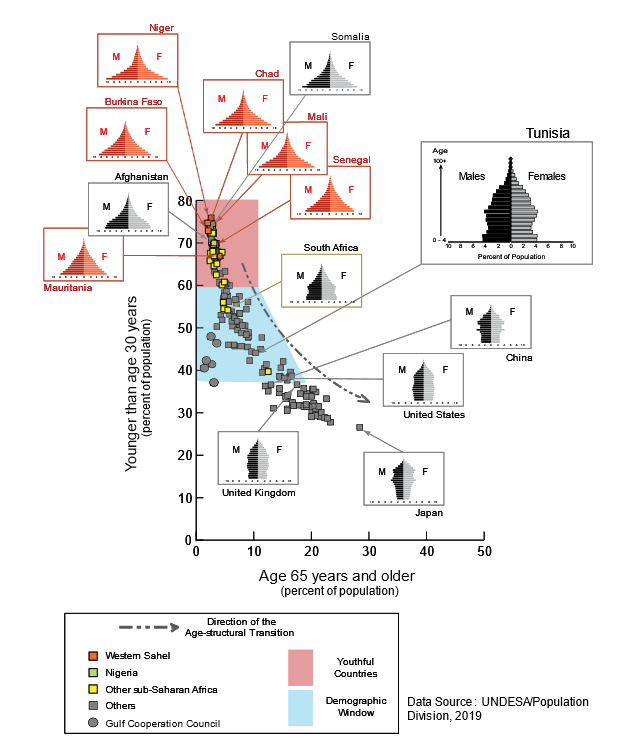
Figure 1. The positions of the six Western Sahelian states in the youthful phase of the age structural transition (note positions of Afghanistan and Somalia).
The remainder of this article is found on the Wilson Center’s New Security Beat website by clicking here.
Or view or download from here
To view or download full Atlantic Council report on Sahelian demography and its implications click here.
Attachments
Thomas Sankara’s Lost Legacy
Woodrow Wilson Center Global Fellow/Senior Fellow, The Population Institute

Thirty-four years ago, Burkina Faso’s president, Thomas Sankara, was murdered. Only now are his alleged assassins on trial. Had he survived, the arid, landlocked country of more than 20 million people might well have taken a far different path to development.

More media attention has focused on former-president Thomas Sankara’s modest salary and lifestyle, than the most audacious and forward-thinking of his reforms: his pro-women policies and programs. Sankara encouraged girls to finish secondary school and earn income, introduced voluntary family planning programs, and required schools to allow pregnant students to return to finish their education. Long before African leaders paid attention to women’s rights, Sankara’s government outlawed female genital cutting, forced marriages, and polygamy. Sankara also appointed women to cabinet positions and other top government posts, and mandated women’s participation in village governing committees. His was the first among African governments to recruit women into the military.
To read the complete essay on Sankara, go to The New Security Beat site.
To view or download a .pdf of the essay, click here.
Or, for the full report, go to the Atlantic Council’s “What Future for the Western Sahel?”

